
Does A Weak Core Cause Back Pain? Not Always!
A Weak Core Doesn't Always Cause Back Pain
A weak core doesn't always mean you will have back pain, but in many cases, yes, it can contribute to or worsen back pain.
It can seem intuitive to want to strengthen your core when you have back pain, but whether you are strengthening your core or just improving your overall strength, it will help improve, alleviate, and prevent back pain. I have had so many patients tell me, "I know my weak core is causing my back pain."
Back pain is the most complex and costly musculoskeletal condition, and if we had a FIX, we would know. Exercise does help, but you need to consider things such as how much it is, how it's done, and what is appropriate for your body!
There are many types of back pain out there! Including sciatica, stenosis, muscle strains, and herniations! Each has its own presentation and how it feels to you.
While back pain is common most back pain is non-specific, in that we don't know the exact cause but that really doesn't matter when it comes to treatment. They all typically respond well to core strengthening.
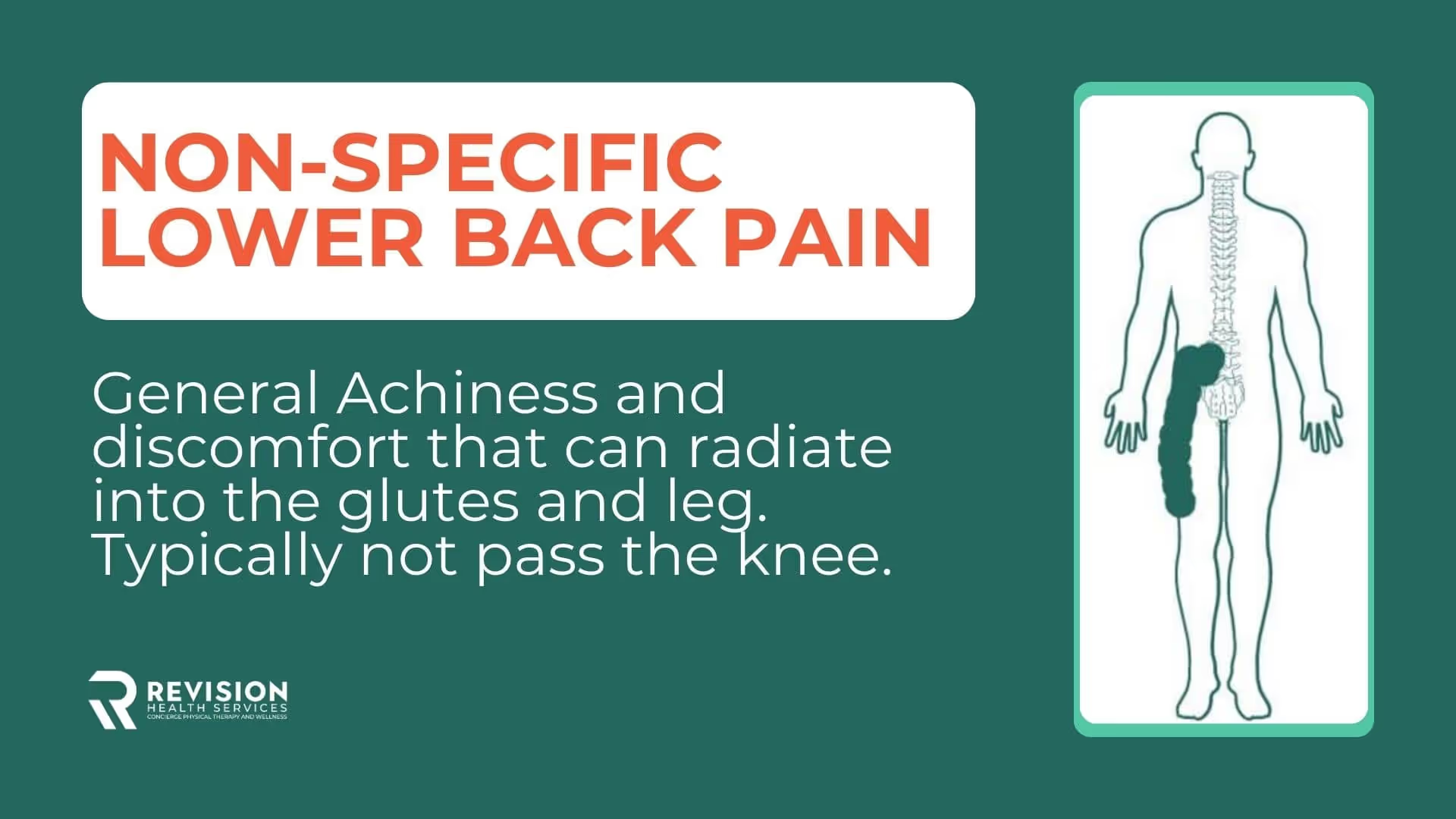
Signs A Weak Core Is Causing Back Pain
One of the most telling signs that a weak core is contributing to a patient’s back pain is difficulty getting out of bed or off the couch without multiple attempts. If sitting up or standing requires rocking or building momentum, it indicates an inability to generate sufficient strength and maintain control throughout a range of motion. As a physical therapist, this signals a core weakness that may be playing a role in their back pain. Recognizing these signs and addressing them is an essential first step in developing an effective core strengthening program to improve back pain and overall function.
Exploring the Link Between Weak Core Strength and Back Pain
Ten years ago, many healthcare providers believed that a weak core was the primary cause of back pain. Today, we understand back pain as a complex issue with various causes—muscle-related, disc-related, chronic, and nerve-related—each requiring different treatments. While core strengthening isn’t a one-size-fits-all solution, it’s beneficial for conditions like arthritis, mobility deficits, and hypermobility. Arthritis-related back pain, common in individuals over 50, often improves with exercises targeting the back and hips. Mobility deficits, seen in those with sedentary lifestyles, respond well to a mix of movement and core strengthening to reduce stiffness and discomfort.
For individuals with hypermobility, core exercises are crucial for providing stability and preventing excessive movement that can lead to pain. Effective exercises include planks, banded side steps, and squats. It’s important to remember that the core is more than just abs—it includes muscles from the neck to the pelvis, supporting posture and movement. While core strengthening isn’t the answer for all types of back pain, understanding the underlying cause helps guide the right approach, and targeted exercises can significantly improve function and provide lasting relief.
How Do You Fix a Weak Core?
When working with my patients and we are focusing on improving a weak core, where is what we do:
- Walking program - Yes walking improves core strength
- 1-2/week specific core strengthening
- 1-2/week general strengthening
- Total of 60-120 min a week of exercise
Generally, we think of core as abs but really, it’s everything. Your core can also be thought of as your trunk (upper body, lower body, and core) which makes core strengthening that much more fun! For example, doing core exercises using a stability ball! You are literally weeks away from a stronger core if you just put in the time and effort.
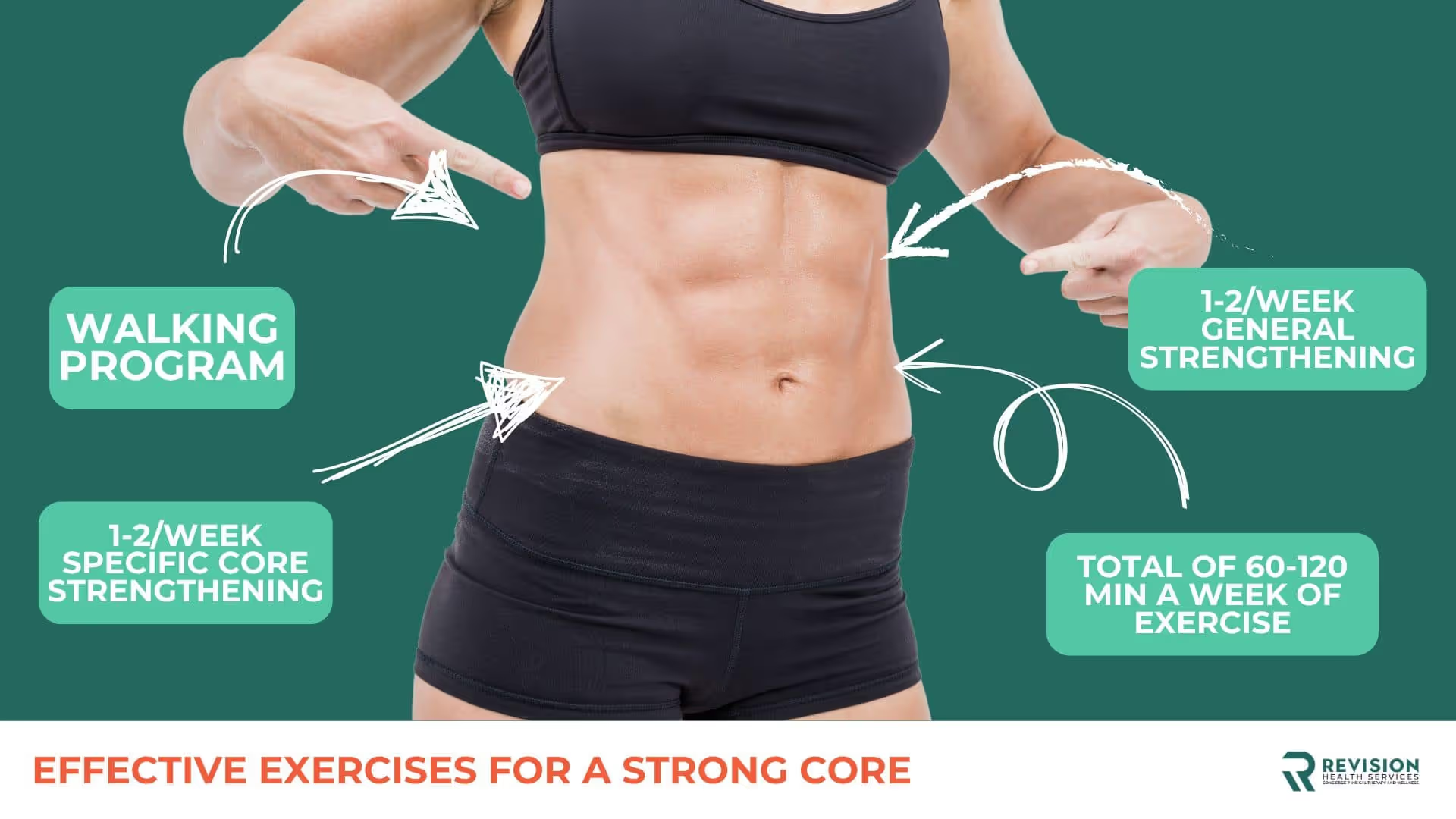
How Strengthening Your Core Can Alleviate and Prevent Lower Back Pain?
Absolutely core strengthening exercises help lower back pain. In fact, we see that core strengthening is a well-studied intervention to assist in treating new and chronic lower back, pain. Lower back pain is by far the most common condition I treat and when I work with clients who are battling lower back pain, we always include core strengthening.
When we think of core and lower back pain, we need to remember that the core is essentially neck to pelvis and it includes the lower back muscles, abdominals, and even glutes! A well-structured core strengthening program includes all of these.
What we need to remember is that the types of lower back pain impact the type of core strengthening. Here are some of the more common conditions and examples I treat.
- Sciatica
- Arthritis or Degeneration
- Hypermobility
- Disc bulges
6 Core Strengthening Exercises to Alleviate Back Pain
The key to improving or alleviating back pain through core strengthening lies in the amount of time and consistency dedicated to training. Core and general strength training have repeatedly proven to be effective treatments for back pain. However, what remains less clear is the exact amount required to create meaningful change. Think of exercise and core strengthening like medication—you need the right dosage to see results. This is where many people fall short.
For my patients focusing on core strengthening to reduce or eliminate back pain, we aim for at least 20 to 25 minutes of targeted exercises, performed progressively, at least three days a week. Over time, we gradually increase the difficulty of exercises to build strength effectively. One of the most common mistakes people make is performing the right exercises but not executing them with the appropriate intensity or progression. This is where a physical therapist can provide guidance and structure.
It’s important to acknowledge that conditions like sciatica, arthritis, and disc issues may require modifications, but in general, if you want to use core strengthening to improve your back health, you should commit to at least three days a week with a minimum of 25 minutes per session. This typically involves four to five exercises, performed in sets of two to three each. Here’s an example of an effective core-strengthening routine:
- Thread the Needle
- Full Range of Motion Squat
- Walking Lunge
- Modified Push-Up
- Bird Dog with Full Range of Motion
You can find these exercises and descriptions in my core strengthening book!
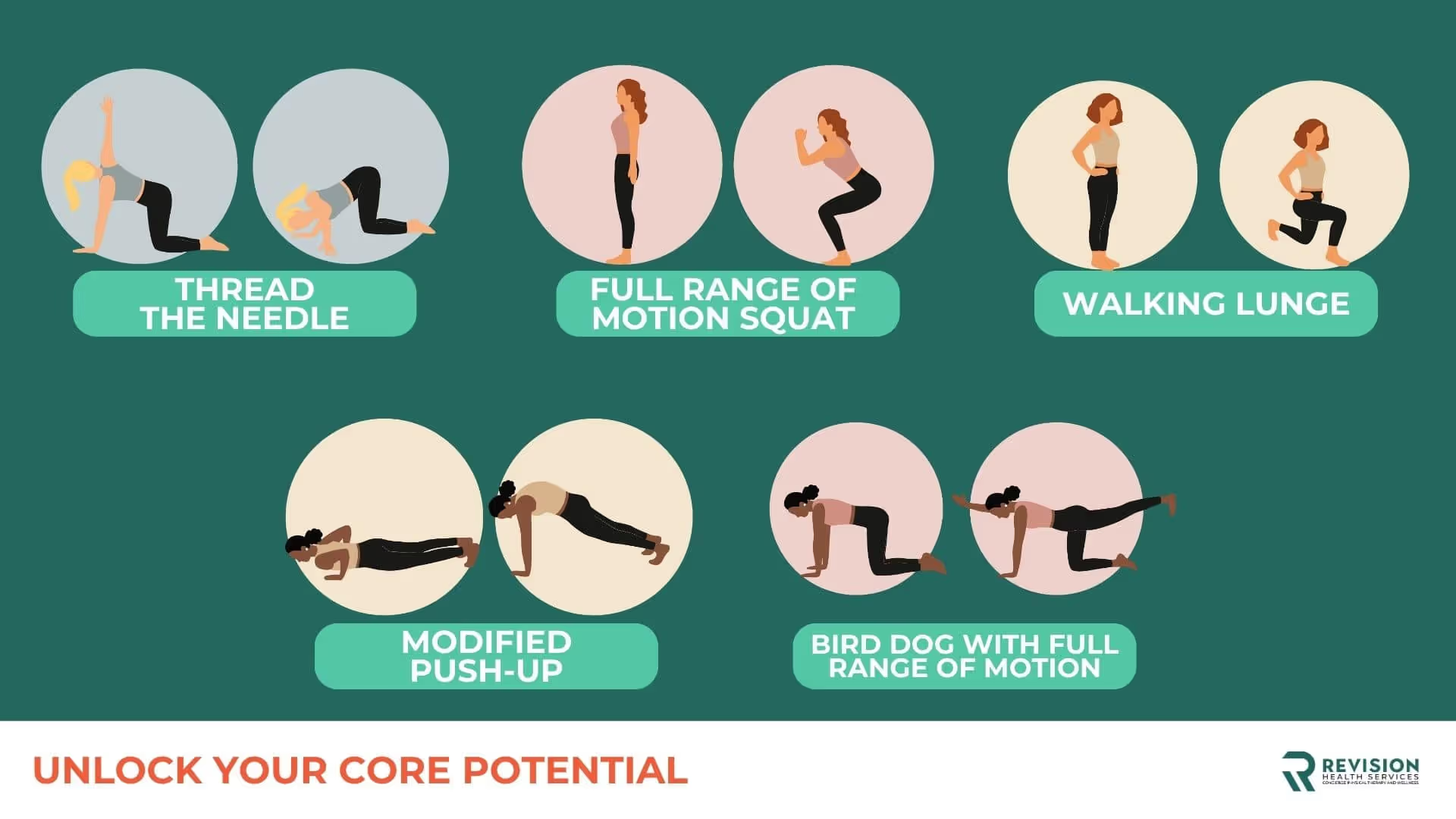
How Do I Strengthen My Core to Prevent Back Pain?
To strengthen your core and build resiliency against current and future back pain, you need a solid workout plan to follow and a little consistency!
- 60-120 minutes a week of total exercise
- 4-8 weeks of consistency
- 4-5 days each week doing some sort of exercise
While a weak core will not always cause back pain, we see that those who strengthen their core will often have less back discomfort. Not only will they have less back pain but they will have more over muscle mass and resiliency thus improving their ability to prevent back pain and other aches and pains! Check out this Free Core Strengthening PDF I made for those wanting to know exactly what and how to do simple to advanced core strengthening.
For types of strengthening we are seeing that pilates when compared to aerobic exercise (walking, running) resistance training (weight lifting), yoga, and stretching, appears to have a leg up. When thinking about this and discussing with my patients, what gives pilates an advantage may be it's dedicated time to strengthening the core using your upper and lower body, time spent discussing learning how to strengthen, and doing enough repetitions.
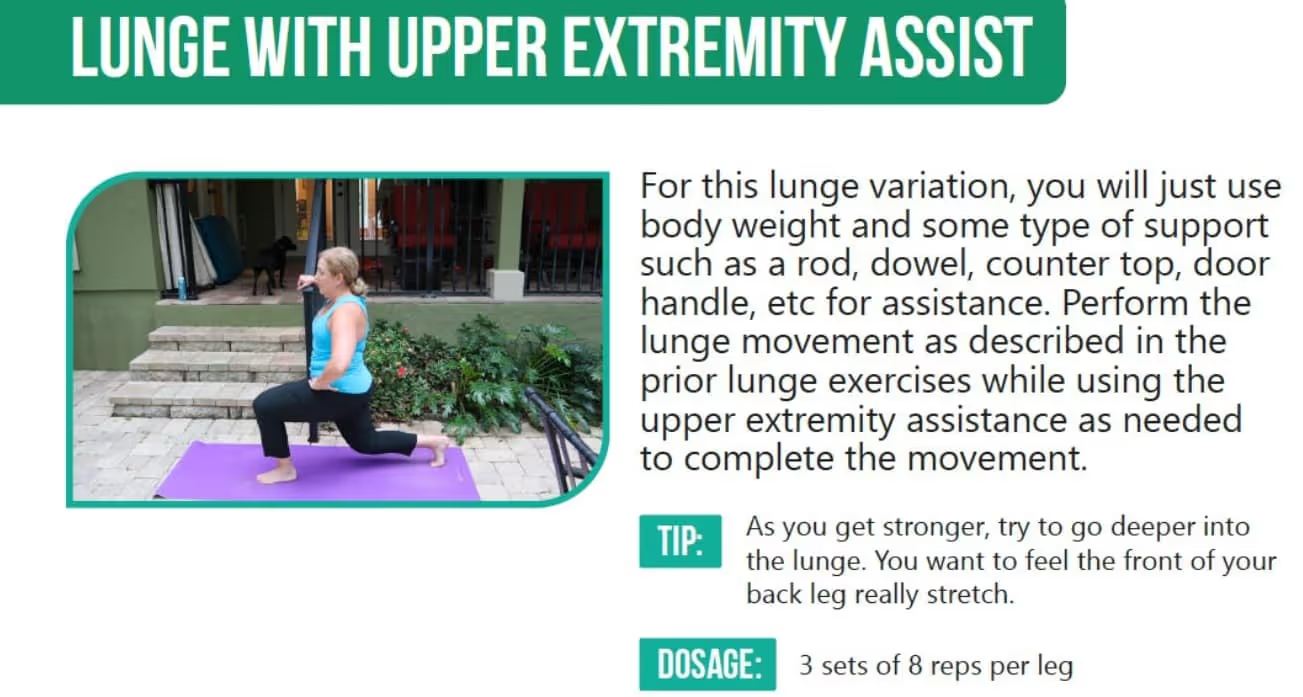
Just like medication, if you don't do enough core strengthening you will not have an improvement in core strength.
Free 24 Exercises Core Strengthening PDF You Can Do At Home
Use this core strengthening PDF I developed to help you learn exactly how to strengthen your core and what it should feel like. 24 exercises that you can do to help develop your own core specific workout.
Learn what to do, how to do it, and what it should feel like!
In conclusion, strengthening your core can significantly reduce back discomfort and enhance overall muscle mass and resilience. By incorporating consistent exercise routines, such as pilates, and following structured programs, you can effectively prevent and manage back pain. Don't hesitate to reach out if you have any questions or need personalized guidance. Be sure to download the free Core Strengthening PDF to get started on your journey to a stronger, healthier core today!
References
A Weak Core Doesn't Always Cause Back Pain
A weak core doesn't always mean you will have back pain, but in many cases, yes, it can contribute to or worsen back pain.
It can seem intuitive to want to strengthen your core when you have back pain, but whether you are strengthening your core or just improving your overall strength, it will help improve, alleviate, and prevent back pain. I have had so many patients tell me, "I know my weak core is causing my back pain."
Back pain is the most complex and costly musculoskeletal condition, and if we had a FIX, we would know. Exercise does help, but you need to consider things such as how much it is, how it's done, and what is appropriate for your body!
There are many types of back pain out there! Including sciatica, stenosis, muscle strains, and herniations! Each has its own presentation and how it feels to you.
While back pain is common most back pain is non-specific, in that we don't know the exact cause but that really doesn't matter when it comes to treatment. They all typically respond well to core strengthening.

Signs A Weak Core Is Causing Back Pain
One of the most telling signs that a weak core is contributing to a patient’s back pain is difficulty getting out of bed or off the couch without multiple attempts. If sitting up or standing requires rocking or building momentum, it indicates an inability to generate sufficient strength and maintain control throughout a range of motion. As a physical therapist, this signals a core weakness that may be playing a role in their back pain. Recognizing these signs and addressing them is an essential first step in developing an effective core strengthening program to improve back pain and overall function.
Exploring the Link Between Weak Core Strength and Back Pain
Ten years ago, many healthcare providers believed that a weak core was the primary cause of back pain. Today, we understand back pain as a complex issue with various causes—muscle-related, disc-related, chronic, and nerve-related—each requiring different treatments. While core strengthening isn’t a one-size-fits-all solution, it’s beneficial for conditions like arthritis, mobility deficits, and hypermobility. Arthritis-related back pain, common in individuals over 50, often improves with exercises targeting the back and hips. Mobility deficits, seen in those with sedentary lifestyles, respond well to a mix of movement and core strengthening to reduce stiffness and discomfort.
For individuals with hypermobility, core exercises are crucial for providing stability and preventing excessive movement that can lead to pain. Effective exercises include planks, banded side steps, and squats. It’s important to remember that the core is more than just abs—it includes muscles from the neck to the pelvis, supporting posture and movement. While core strengthening isn’t the answer for all types of back pain, understanding the underlying cause helps guide the right approach, and targeted exercises can significantly improve function and provide lasting relief.
How Do You Fix a Weak Core?
When working with my patients and we are focusing on improving a weak core, where is what we do:
- Walking program - Yes walking improves core strength
- 1-2/week specific core strengthening
- 1-2/week general strengthening
- Total of 60-120 min a week of exercise
Generally, we think of core as abs but really, it’s everything. Your core can also be thought of as your trunk (upper body, lower body, and core) which makes core strengthening that much more fun! For example, doing core exercises using a stability ball! You are literally weeks away from a stronger core if you just put in the time and effort.

How Strengthening Your Core Can Alleviate and Prevent Lower Back Pain?
Absolutely core strengthening exercises help lower back pain. In fact, we see that core strengthening is a well-studied intervention to assist in treating new and chronic lower back, pain. Lower back pain is by far the most common condition I treat and when I work with clients who are battling lower back pain, we always include core strengthening.
When we think of core and lower back pain, we need to remember that the core is essentially neck to pelvis and it includes the lower back muscles, abdominals, and even glutes! A well-structured core strengthening program includes all of these.
What we need to remember is that the types of lower back pain impact the type of core strengthening. Here are some of the more common conditions and examples I treat.
- Sciatica
- Arthritis or Degeneration
- Hypermobility
- Disc bulges
6 Core Strengthening Exercises to Alleviate Back Pain
The key to improving or alleviating back pain through core strengthening lies in the amount of time and consistency dedicated to training. Core and general strength training have repeatedly proven to be effective treatments for back pain. However, what remains less clear is the exact amount required to create meaningful change. Think of exercise and core strengthening like medication—you need the right dosage to see results. This is where many people fall short.
For my patients focusing on core strengthening to reduce or eliminate back pain, we aim for at least 20 to 25 minutes of targeted exercises, performed progressively, at least three days a week. Over time, we gradually increase the difficulty of exercises to build strength effectively. One of the most common mistakes people make is performing the right exercises but not executing them with the appropriate intensity or progression. This is where a physical therapist can provide guidance and structure.
It’s important to acknowledge that conditions like sciatica, arthritis, and disc issues may require modifications, but in general, if you want to use core strengthening to improve your back health, you should commit to at least three days a week with a minimum of 25 minutes per session. This typically involves four to five exercises, performed in sets of two to three each. Here’s an example of an effective core-strengthening routine:
- Thread the Needle
- Full Range of Motion Squat
- Walking Lunge
- Modified Push-Up
- Bird Dog with Full Range of Motion
You can find these exercises and descriptions in my core strengthening book!

How Do I Strengthen My Core to Prevent Back Pain?
To strengthen your core and build resiliency against current and future back pain, you need a solid workout plan to follow and a little consistency!
- 60-120 minutes a week of total exercise
- 4-8 weeks of consistency
- 4-5 days each week doing some sort of exercise
While a weak core will not always cause back pain, we see that those who strengthen their core will often have less back discomfort. Not only will they have less back pain but they will have more over muscle mass and resiliency thus improving their ability to prevent back pain and other aches and pains! Check out this Free Core Strengthening PDF I made for those wanting to know exactly what and how to do simple to advanced core strengthening.
For types of strengthening we are seeing that pilates when compared to aerobic exercise (walking, running) resistance training (weight lifting), yoga, and stretching, appears to have a leg up. When thinking about this and discussing with my patients, what gives pilates an advantage may be it's dedicated time to strengthening the core using your upper and lower body, time spent discussing learning how to strengthen, and doing enough repetitions.

Just like medication, if you don't do enough core strengthening you will not have an improvement in core strength.
Free 24 Exercises Core Strengthening PDF You Can Do At Home
Use this core strengthening PDF I developed to help you learn exactly how to strengthen your core and what it should feel like. 24 exercises that you can do to help develop your own core specific workout.
Learn what to do, how to do it, and what it should feel like!
In conclusion, strengthening your core can significantly reduce back discomfort and enhance overall muscle mass and resilience. By incorporating consistent exercise routines, such as pilates, and following structured programs, you can effectively prevent and manage back pain. Don't hesitate to reach out if you have any questions or need personalized guidance. Be sure to download the free Core Strengthening PDF to get started on your journey to a stronger, healthier core today!
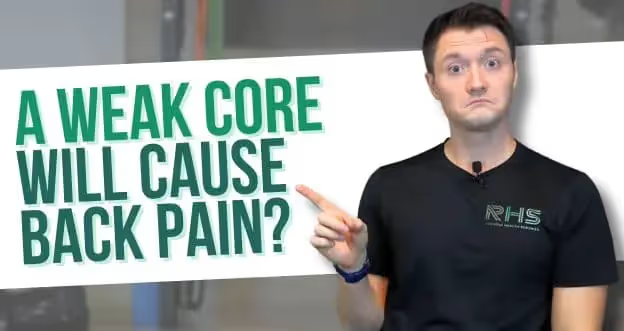


%20Blog%20thumbnails%204.avif)
%20Blog%20thumbnails.avif)
%20Core%20workout%20for%20Sciatica.avif)
%20Sciatica%20and%20Lower%20back%20Pain%20Workout.avif)
%20B%26A%20Back%20Surgery.avif)

%20Older%20Adult%20Workout%20for%20Sciatica%20Without%20Getting%20on%20the%20floor.avif)

%20FREE%2024%20Core%20Strengthening%20Exercises%20PDF%20Guide.avif)

%20FREE%20Sciatica%20Pain%20Relief%20PDF.avif)

%20Ultimate%20Sciatica%20Stretch%20Workout.avif)
%20%20I%20Have%20Some%20Extra%20Cushion%20Workout%20With%20Sciatica.avif)
%20The%20Ultimate%20Guide%20for%20Stretching%20Your%20Lower%20Back!.avif)
%20V1.avif)



%20Core%20Calendar.avif)
